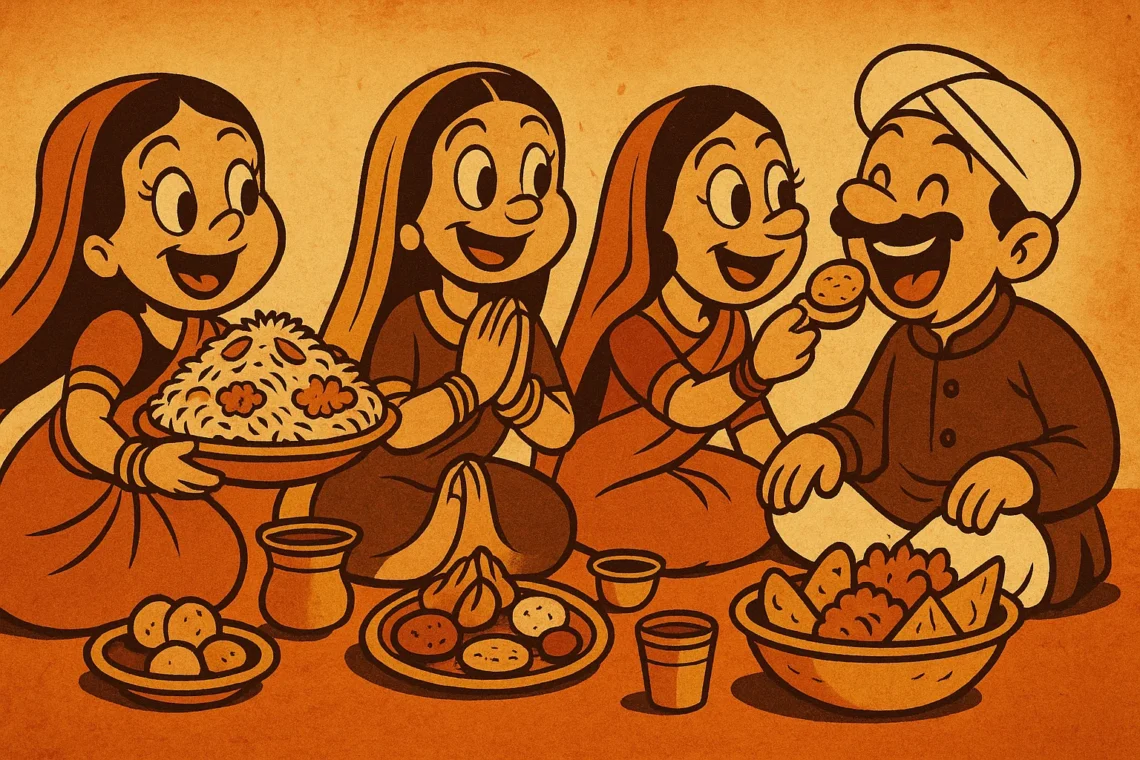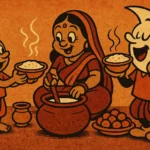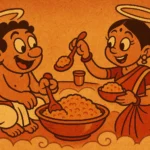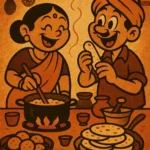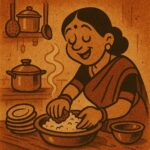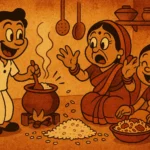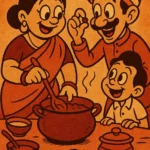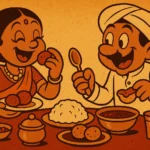Growing up in Mumbai, there was one thing you could always count on: the drama unfolding on the TV screen and the *fasting queens* at the center of it. No, I’m not talking about your typical television heroines, but rather those who seemed to take fasting to an art form. They were the women who observed Karva Chauth, a day dedicated to fasting for the long life of their husbands, and in the process, gave us some of the most iconic moments in Indian TV serials. These women were always poised, always graceful, and always determined to see the day through without a sip of water—sometimes, without even a trace of food.
And then came the big moment: the sargi. For those who don’t know, the sargi is the meal eaten before dawn on Karva Chauth, a symbol of love, sacrifice, and tradition. It’s rich, nourishing, and full of meaning—both for the body and the heart. In TV serials, the sargi wasn’t just about food; it was a cinematic spectacle of devotion. In many households, it’s a cherished tradition, and the food plays a role that’s almost as sacred as the fast itself.
The Fasting Rituals: TV’s Love, Sacrifice, and the Waiting Game
If you’ve ever watched a soap opera on Indian television, you know the scene. The heroine—dressed in the most beautifully draped saree, her eyes filled with a mixture of determination and affection—wakes up before sunrise. With her closest friends and relatives gathered around, she’s presented with the sargi, a plate piled high with fruits, sweets, and sometimes a small portion of the husband’s favorite foods, like *puri*, *sookha chawal*, or *halwa*. There’s always a quiet moment of reflection before the sargi is consumed. It’s a ritual that says so much about the emotional and physical commitment that comes with fasting. It’s not just food; it’s a symbol of devotion, a loving offering, and a demonstration of sacrifice.
In many ways, these fasting scenes on TV are as dramatic as the relationship they depict. The fasting heroines are the pillars of their homes, their love unshaken by the long hours spent without food or water. The slow, careful ritual of eating sargi before the fast is a demonstration of how food can symbolize something much greater. It represents sacrifice, devotion, and a deep connection between two people, especially the bond between husband and wife. As much as the sargi is a personal meal, it’s also an offering—a way of giving. And it’s these quiet moments that, despite the larger-than-life soap opera drama, remind us of the deep roots of tradition in Indian food culture.
The Meaning of Sargi: More Than Just Food
The sargi is special because it’s not just about eating before the fast begins—it’s about starting the day in a way that’s filled with love and gratitude. Traditionally, the sargi is a family affair. It’s a meal that often gets passed down from mother to daughter, grandmother to granddaughter. It’s rich with symbolism and a reflection of the love and care that goes into preparing it. It’s not just a plate of food; it’s the act of nourishment and the unspoken understanding that the fast will be supported with every bite of the sargi. For a woman, it’s a message that she’s cared for, and for her family, it’s a reminder of the importance of love, faith, and tradition.
Now, in modern-day celebrations of Karva Chauth, some things have changed. The sargi might include more contemporary ingredients, and some women might even share their sargi moments on social media, but the sentiment remains unchanged. It’s still a meal that represents devotion, love, and the deep emotional connections that food helps to foster. The sargi is not just a symbol of the fast—it’s a cultural moment, one that’s rooted in history, myth, and modernity.
Why We’re Drawn to the Fasting Queens of TV
So why do we love watching these fasting queens on TV? Why are we drawn to the drama, the sacrifice, and the tension of a woman trying to fast for the entire day? Maybe it’s because we see a reflection of ourselves in their determination. Maybe it’s because, despite the overwhelming drama of the TV serials, there’s a universal theme at play—the theme of sacrifice, of doing something for the ones we love, even when it seems impossible. There’s a kind of quiet strength in these characters, a strength that comes not just from their love, but from their devotion to tradition and family.
And it’s not just about food. The act of fasting, like the act of cooking, is a ritual that brings us closer to ourselves and to our families. It connects us to generations past, who upheld these customs and taught us how food and love are intricately tied together. The fasting queens of TV remind us of the power of tradition, and how something as simple as food can carry so much weight.
Food as a Metaphor for Connection
The sargi isn’t just food; it’s a metaphor. It’s about connection—between the woman fasting and her family, between generations who have passed down the tradition, and between food and faith. It’s about nourishment, not just for the body, but for the spirit. It’s a way of honoring the importance of relationships, whether romantic or familial, and recognizing that food has the power to symbolize those connections. It’s a moment where food becomes more than just sustenance—it becomes a living, breathing thing that links us to something greater than ourselves.
For many of us, the connection to food and culture is passed down through stories, through rituals, through our families. It’s these moments—the quiet sargi before a fast or the shared meals around the table—that form the fabric of our lives. The fasting queens of TV might be a little over-the-top, but they bring to life the fundamental truth that food connects us in ways that words often can’t.
The Quiet Power of Ritual
In the end, it’s not just the fasting or the food that makes these TV scenes so powerful—it’s the quiet power of ritual. The sargi, like many food rituals in Indian culture, is a reminder that food is not just about filling our stomachs; it’s about connecting us to tradition, love, and faith. It’s about honoring the rituals that have come before us, and passing them down to the next generation. The fasting queens of TV might be fictional characters, but their rituals—like the sargi—are rooted in real cultural practices that continue to shape the way we experience food, love, and life itself.
So, the next time you’re watching your favorite soap opera and a sargi scene plays out, remember: it’s not just food on the table. It’s a symbol of love, sacrifice, and connection. It’s a piece of tradition, served up in the most dramatic way possible, and we wouldn’t want it any other way.
Born in Mumbai, now stir-frying feelings in Texas. Writes about food, memory, and the messy magic in between — mostly to stay hungry, sometimes just to stay sane.

